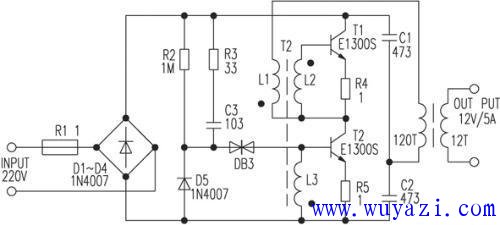Cw7809 constitutes a switching regulator power supply, requires a maximum output current of 0.5A digitally controlled DC power supply circuit, uses the control button to select the output voltage (1·5-15V step change), and uses LED to indicate the output voltage value. It has the characteristics of convenient adjustment and intuitive display.
Circuit Operation Principle The digitally controlled DC stabilized power supply circuit consists of a voltage regulator circuit and an output voltage control circuit, as shown in the figure.

The voltage stabilizing circuit is composed of a power switch Sl, a power transformer T, a rectifier bridge stack UR, a capacitor Cl-C3, a three-terminal voltage regulator integrated circuit lCl, lC3 and a resistor RO-RlO.
The output voltage control circuit is composed of a control button S2, a reset button S3, a resistor R11-R31, a transistor Vl-VIO, a light-emitting diode VLl-VLlO, and a decimal counter/divider integrated circuit IC2. Due to space limitations, the circuits are drawn at the end of Rl2-Rl9, R22-R29, VL2-VL9, and V2-V9.
Turn on Sl, AC 220V voltage after T step-down, UR rectification, Cl and C2 filter, one way as the regulator input voltage is added to ICl's 3 feet, output after ICl voltage regulation; the other way is regulated by lC3 to 9V As the working power of IC2.
IC2 after power-on reset, its YO terminal (3 feet) outputs a high level, so that Vl is turned on, Rl is grounded through the internal resistance of Vl, and the voltage is connected to the voltage regulator circuit (R2-RlO via Vl conduction internal resistance) Short circuit to ground) The output voltage of IC1 is 1.5V; the VLl is lit, indicating that the output voltage is 1.5V.
Press S2, lC2 CP end (14 feet) to input a high-level pulse, IC2 starts counting, its Yl terminal outputs a high level, so that V2 is turned on, Rl and R2 are connected to the voltage regulator circuit (R3-RlO After V2's conduction internal resistance is short-circuited to ground), the output voltage of lCl rises to 3V, VL2 lights up; at the same time, the YO terminal of lC2 becomes low level, Vl is cut off, and VLl is extinguished.
Press S2 continuously, the YO-Y9 output of lC2 will output high level in turn, the output voltage of ICl will increase by 1. 5V step, and the corresponding LED will light up, indicating the output voltage value. When the Yg terminal of IC2 outputs a high level, VlO is turned on, and Rl-RlO is all connected to the voltage stabilizing circuit, and the output voltage of lCl is 1.5V; at the same time, VLlO is lit, indicating that the output voltage is l5V.
After pressing the reset button S3, IC2 is forced to reset, and its M terminal outputs a high level, and the output voltage of ICl is 1·5V.
Changing the resistance of RO-RlO can change the level of the regulated output voltage.
Component selection RO-RlO selects 1/2W precision metal film resistor for use; Rll-R31 selects 1/4W metal film resistor or carbon film. Both Cl and C2 select Aluminum Electrolytic Capacitors. The withstand voltage of Cl is 35V, C2 The withstand voltage is 25V.
VLl-VLlO selects φ3mm or φ5mm LEDs.
UR uses 2A, 5OV rectifier bridge stack.
Vl-VlO selects S805O or C8050, 3DG8050 silicon NPN transistor.
ICl selects LM317 type three-terminal adjustable voltage regulator integrated circuit; IC2 selects CD4017 or MCl4017 type decimal counting/distributor integrated circuit; IC3 selects LM7809 or CW7809 type three-terminal regulator integrated circuit.
T selects lOW, the secondary voltage is 18V power transformer.
Bi Directions Thyristor (Triac)
Bi Directions Thyristor (Triac) is equivalent to the antiparallel connection of two unidirectional thyristors, but only one control pole.
Bidirectional thyristors are made of N-P-N-P-N five-layer semiconductor materials, and three electrodes are also derived from the outside. Its structure is shown in the figure. Bi-directional thyristor volt-ampere characteristic curve Since the forward and reverse characteristics of the bidirectional thyristor are symmetrical, it can be turned on in any direction and is an ideal AC switching device.
Bi Directions Thyristor,Electronic Components Triac,Power Thyristor For Inverter,Silicon Power Bipolar Transistors
YANGZHOU POSITIONING TECH CO., LTD. , https://www.cnchipmicro.com
